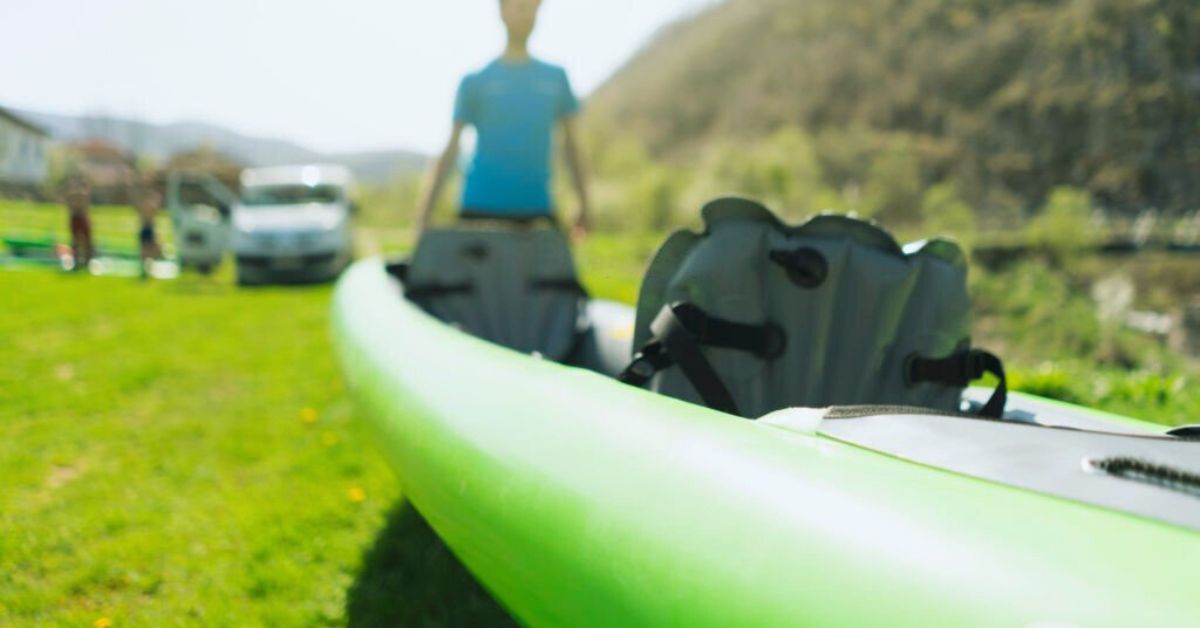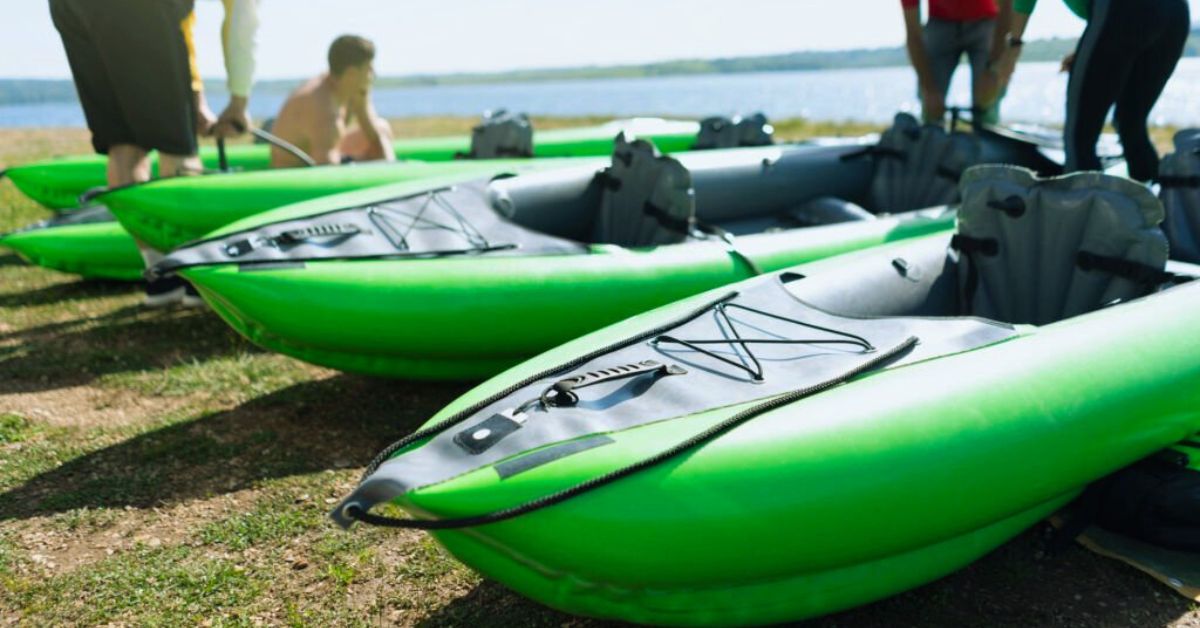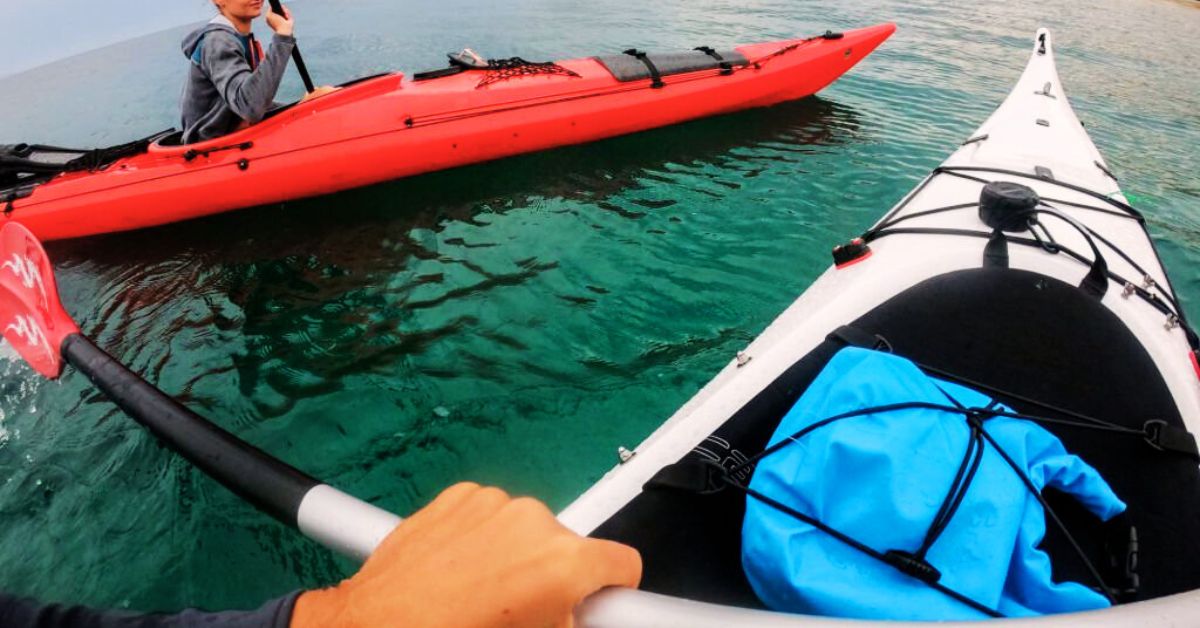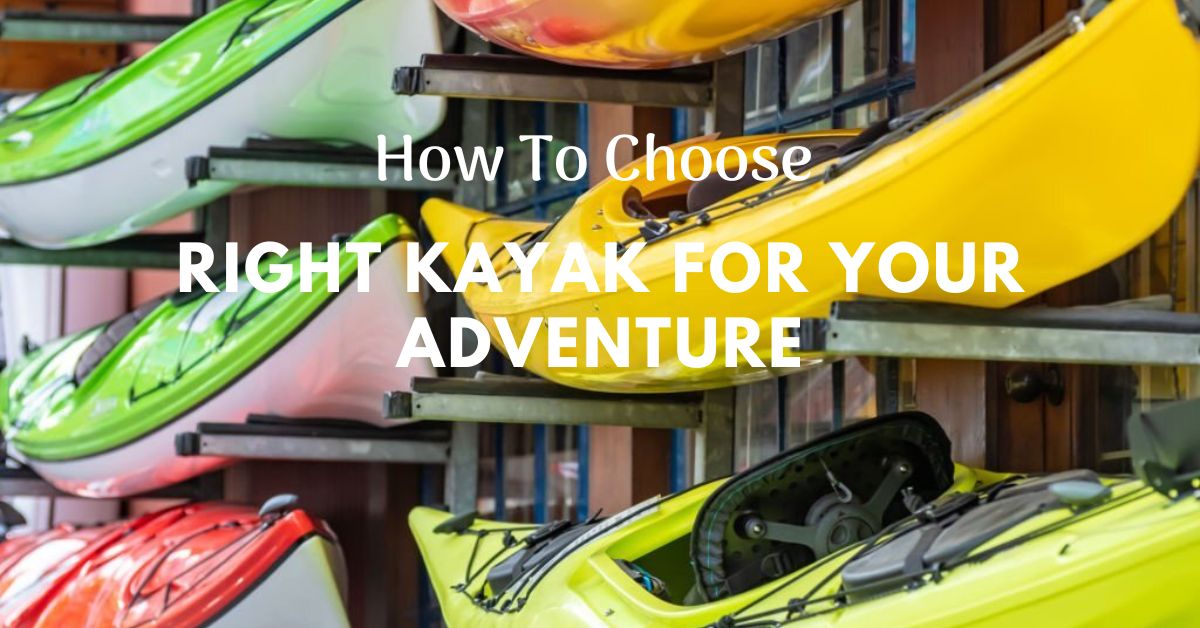If you’re new to the sport, buying a kayak can be both exciting and daunting. With numerous options in terms of type, size, and features, it’s easy to feel overwhelmed.
But fear not! With some research and consideration of your needs and preferences, you’ll find the perfect kayak for you.
In this guide, we’ll provide valuable tips on how to buy a kayak. We’ll cover important factors to consider, explore different kayak types, and help you choose the one that suits you best.
From exploring different types of kayaks to understanding key features and what to consider when making your purchase, we’ve got you covered. Get ready to embark on your kayaking journey feeling prepared and excited!
Table of Contents
How To Choose The Right Kayak For Your Adventure
Choosing the perfect kayak for your adventure is an important decision that requires thoughtful deliberation. With so many options available in the market, it can be overwhelming to find the one that fits your needs.
Whether you’re a beginner or a seasoned kayaker, selecting the right kayak can significantly enhance your experience.
Factors such as the type of water you’ll be paddling in, your skill level, and the duration of your trip are crucial considerations when making this choice.
1. Sitting Kayaks
Seat-on-top kayaks are ideal for novices and leisure paddlers. These open kayaks let you sit on top rather than in a cockpit.
For calm seas, lakes, and slow-moving rivers, they are steady and simple to handle. Sit-on-top kayaks are popular for fishing and enjoyment due to their simple access and egress.
2. Touring Kayaks
Sea kayaks, sometimes known as touring kayaks, are built for longer travels on open waters like lakes or oceans. With a longer and thinner hull, these kayaks are sleek and easy to paddle over long distances.
Large cockpits and storage compartments accommodate gear for long journeys. Intermediate to experienced paddlers wanting adventure may use touring kayaks because to their tracking and stability.
3. Whitewater Kayaks
Whitewater kayaking is for adrenaline junkies who like rapids and stormy rivers. These kayaks are designed for strong currents and swift water.
Shorter whitewater kayaks with rounder hulls and spray skirts prevent water from entering the cockpit. You can traverse rapids and execute exhilarating acrobatics and maneuvers with their mobility and reactivity.
4. Recreational Kayaks
Recreational kayaks are ideal for leisurely kayaking on lakes, ponds, and sluggish rivers. Beginners and those wanting a relaxed paddling experience will love their stability, comfort, and simplicity of usage. Recreational kayaks are broader and shorter for stability and mobility.
5. Inflatable Kayaks
Due of their mobility, inflatable kayaks are becoming more popular. Durable materials make these kayaks suited for varied water conditions, endure punctures and abrasions.
Travelers and people with limited storage space will love inflatable kayaks since they are simple to carry, store, and inflate. Sit-on-top and touring kayaks are offered for different skill levels and preferences.
Understanding kayak kinds and their uses helps you pick the right one for your trip objectives and ability level. When choosing a kayak, focus comfort, stability, and mobility to improve your paddling experience.
Determine your kayaking aims and preferences
Determine your kayaking aims and interests before getting into kayaking. Understanding what you want from kayaking can help you pick the right kayak. Every explorer is different.

Think about your kayaking style. Looking for exhilarating whitewater rapids, tranquil lake excursions, or multi-day sea kayaking? For best performance and safety, each activity demands a distinct kayak.
Next, consider your experience and competence. Do you want a sturdy, easy-to-paddle kayak for beginners or an expert model for demanding conditions? To enjoy and feel confident on the water, pick a kayak that suits your ability level.
Take into mind your appearance and comfort. Your ideal kayak size and design depend on your height, weight, and body shape. Adjustable seats and footrests enable you to modify your kayak for best comfort while paddling.
Lastly, evaluate any desired features or extras. Do you require camping or fishing gear storage? Would you want a kayak with a rudder or skeg for better tracking and maneuverability?
To find the perfect kayak for your journey, it’s important to consider your kayaking goals and personal preferences. Keep in mind that selecting the right kayak can enhance your performance, boost confidence, and make your paddling experience both enjoyable and fulfilling amidst the beauty of nature.
Considering kayak size and weight
Size and weight capacity are vital when picking a kayak for your expedition. The size of the kayak affects comfort, maneuverability, and water type.
Size
First, examine your size and body type. Are you tall or need additional legroom? You need a kayak that fits your height and legs. This will help you paddle comfortably and posture while your journey.
Weight
Additionally, examine the kayak’s weight capacity. This is the kayak’s maximum weight without sacrificing stability or performance.
You should consider your weight and any fishing or camping gear you want to carry. Always pick a kayak with a bigger weight capacity for unforeseen additions.
Keep in mind that kayak size and weight capacity determine the sort of water you may safely cross. Smaller kayaks are ideal for quiet lakes and slow-moving rivers, whereas bigger ones with greater weight capacity are excellent for ocean expeditions.
Choosing the proper kayak size and weight capacity is crucial for safe and enjoyable paddling. Consider your requirements, the sort of water you’ll be exploring, and a kayak that fits your size and gear. The right kayak will give you the confidence to paddle on your next expedition.
Assessing kayak stability and maneuverability
Stability and mobility are vital when picking a kayak for your expedition. These two things may greatly affect your paddling experience and safety.
Stability
Stability is the kayak’s balance and steadiness under varied situations. If you’re a novice or enjoy calm seas, choose a stable kayak. This makes the kayak stable whether resting or paddling in calm conditions.
If you’re an experienced paddler or want to paddle in harsher conditions, you’ll need a kayak with great secondary stability. This stability comes into play when the kayak is tilted or leaning. It improves control and mobility in difficult circumstances.
Maneuverability
Another important factor is maneuverability. How smoothly the kayak reacts to your paddling strokes and changes direction. A kayak with strong mobility can handle tight places, obstacles, and fast turns.
When feasible, test a kayak’s stability and maneuverability on the water. Try it on calm lakes and rivers with diverse currents. Notice how sitting stationary, paddling straight, and turning feels.
Consider design aspects that improve stability and mobility. Wider kayaks have higher initial stability, whereas narrower ones have superior secondary stability and mobility. A kayak’s flat bottom or V-shaped hull may also alter its performance in various water conditions.
Your skill level, usage, and preferences determine the best stability-maneuverability balance. Choose a kayak that inspires confidence on your paddling experiences by researching and testing them.
Examination of kayak construction and durability
One important factor in picking the right kayak for your expedition is its build and longevity. After all, you want a kayak that can handle all water conditions.
First, evaluate the kayak’s materials. Plastic, fiberglass, carbon fiber, and Kevlar are common materials. Choose a material that suits your requirements and tastes since each has pros and cons.
Kayak Durability
Durable and affordable plastic kayaks are one example. They can take waterborne hits from rocks and other objects without injury. However, they may be heavier and less fast or maneuverable than other materials.
However, fiberglass and composite kayaks are lighter and simpler to carry. They also improve water speed and responsiveness. They may be more prone to impact damage, needing cautious handling and upkeep.
Construction
The kayak’s construction is another consideration. Choose kayaks with reinforced hulls and sturdy construction for durability.
Consider kayak bulkheads, which increase structural strength and prevent water from entering the cockpit in the event of a capsize.
Additionally, inspect the kayak’s seams and joints. High-quality kayaks feature well-sealed seams and strong joints for watertightness and durability. High-stress places like the cockpit and seat/hatch connection points may be reinforced to make the kayak more durable.
Examine a kayak’s structure and endurance to make an educated choice that will outlast your voyage.
When purchasing a kayak, it’s important to invest in a high-quality and durable option. This not only brings peace of mind but also enhances your paddling experience, instilling confidence while out on the water.
Selecting the correct kayak material
Selecting the right kayak material is vital to ensure an enjoyable and successful water voyage. The material of your kayak affects its durability, weight, performance, and cost.

Therefore, it is important to have a comprehensive understanding of the various kayak materials available along with their individual advantages and disadvantages before making a purchase decision.
1. Kayak materials is polyethylene (PE). It is recognized for its durability, impact resistance, and roughness. PE kayaks are heavier than others yet stable and scratch-resistant. They are suitable for novices and those who value durability above weight.
2. Composite: Lightweight composites like fiberglass, carbon fiber, and Kevlar function well on water. The price and robustness of fiberglass kayaks make them popular.
Carbon fiber kayaks are lighter and stiffer, improving speed and maneuverability. Expedition kayaks are ideal for Kevlar kayaks’ high strength-to-weight ratio. However, composite kayaks are more costly and need cautious handling to prevent damage.
3. Due of its mobility and storage: Inflatable kayaks are popular, The robust PVC or rubber kayaks may be inflated and deflated for easy travel.
Recreational paddling is possible because to their modest weight and maneuverability. They may not be as stable or effective as hardshell kayaks.
4. Wood: Handcrafted wooden kayaks are useful and beautiful. Handmade ones give a unique paddling experience. Wood floats and is stable on water. Wooden kayaks are more costly and need frequent maintenance.
Consider your skill level, usage, price, and storage possibilities while picking a kayak material. Finding the right mix between durability, weight, and performance is crucial.
Selecting the proper kayak material lets you paddle confidently knowing your kayak will improve your water journey.
Exploring kayak accessories and features
Explore features and accessories while picking a kayak for your expedition. These may improve your paddling experience and guarantee you have all you need for a wonderful trip.
The hull of your kayak is vital. Flat or rounded kayaks are stable and ideal for novices and calm conditions. V-shaped kayaks are faster and more maneuverable, making them perfect for more experienced paddlers or rougher conditions.

The kayak’s seating arrangement is another consideration. A comfy seat may make lengthy paddles much more enjoyable. Find kayaks with adjustable seats for back and leg support. Some kayaks have ergonomic features or extra cushioning for comfort.
Accessories may improve your kayaking experience beyond the basics. A kayak paddle leash is a popular addition that keeps your paddle within reach if it slides. This is beneficial in fast-moving currents and small waterways.
Hatches and bungee cords are other kayak storage solutions that keep your stuff secure and accessible. A dependable kayak anchor system may also keep you from drifting when fishing or taking a rest.
Consider adding a kayak rudder or skeg. In strong currents or windy situations, these attachments help improve tracking and stability. While not essential for every kayaker, they might be useful for more strenuous journeys.
The features and extras you pick will depend on your tastes, the sort of kayaking you intend, and your adventurous demands. To discover the kayak configuration that matches your style and gives you confidence on every excursion, investigate and try numerous choices.
Requesting advice from experienced kayakers
When picking a kayak for your expedition, consulting experienced kayakers might be crucial. These people have kayak selection experience and can provide advice.
Joining kayaking forums and groups might help you access this expertise. These platforms have experienced kayakers who love the sport and are happy to advise. Ask kayak users about models, brands, and features to gain real-world feedback.
Outdoor gear shops and kayak rental businesses are also good sources for reviews. These businesses’ staffs are generally passionate kayakers and may provide significant suggestions based on their own experiences and client feedback. They can recommend a kayak for your skill level, usage, and price.
Attending kayaking competitions or joining local organizations is another great method to meet skilled kayakers. Start discussions, ask for guidance, and listen to their tales. Their personal experiences might help you choose the right kayak for your expedition.
Remember, experienced kayakers may provide helpful advice throughout your kayak choosing process. You may paddle with confidence knowing you made an educated selection that meets your requirements and tastes by researching their suggestions and reviews.
Decide and prepare for your kayaking adventure
The final kayak choice is an exciting point in your kayaking experience. After careful study and considering all your priorities, make your buy. However, there are a few more measures to do to prepare for your kayaking trip.
First, confirm that your kayak suits all your needs. Is its size and weight capacity sufficient? Does it have storage, comfy sitting, and adjustable footrests? Confirming these information helps guarantee your kayak is functional and comfortable on your voyage.
Consider any extra accessories or equipment. Purchase a nice paddle, life jacket, waterproof bag, or kayak cart for convenient transporting, depending on the sort of kayaking you want to perform. Gathering these necessities ahead of time will let you concentrate on your journey rather than last-minute rushing.
After getting your kayak and accessories, learn them. Adjust the seats and footrests, practice getting in and out of the kayak, and practice paddle strokes. These basic measures will boost your confidence and improve your aquatic experience.
Finally, plan and study your kayaking trip. Explore several waterways and choose one that suits your skills and interests. Consider weather, risks, and local restrictions and permissions. By planning beforehand, you may enjoy kayaking safely.
Choosing a kayak and planning for your expedition is the last step to paddling confidently. All that’s left is to enjoy the open sea, discover new places, and make memories in your ideal kayak.
Hope you found our advice on picking the right kayak. Any kayaker needs confidence, and the correct kayak may make all the difference.
Follow the steps in this blog article to choose the kayak that best meets your requirements and tastes for a safe and fun water trip.
